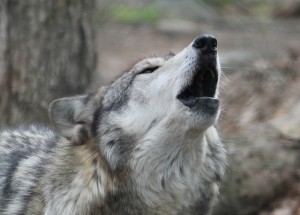FRIDAY, 19 FEBRUARY 2016

Even subspecies of canids able to interbreed are distinguished by their 'dialects'.
In order to analyse canid calls, the researchers collected over 2000 howls of 13 distinct species and subspecies. Then they used machine-learning algorithms to sort these calls into discrete types. They found that each species and subspecies used very different howl types. This suggests that canid howls are not arbitrary, but instead encode species-specific information. This is the most comprehensive study of canid communication calls to date, and the first one to use machine-learning in this research area.
How human language evolved and what drove the diversity of languages we have today are questions that remain unanswered. Because our closest relatives, the chimpanzees, have relatively simple vocal communication systems, it is difficult to compare our language to theirs. Lead researcher Arik Kershenbaum and collaborators think that understanding how animals living in complex societies communicate with one another could grant us insight into the evolution of our own language. Furthermore, the scientists note that their findings might help in the planning and management of canid conservation programs.
DOI: 10.1016/j.beproc.2016.01.006
Image by Fool4myCanon
Written by Ornela De Gasperin.
